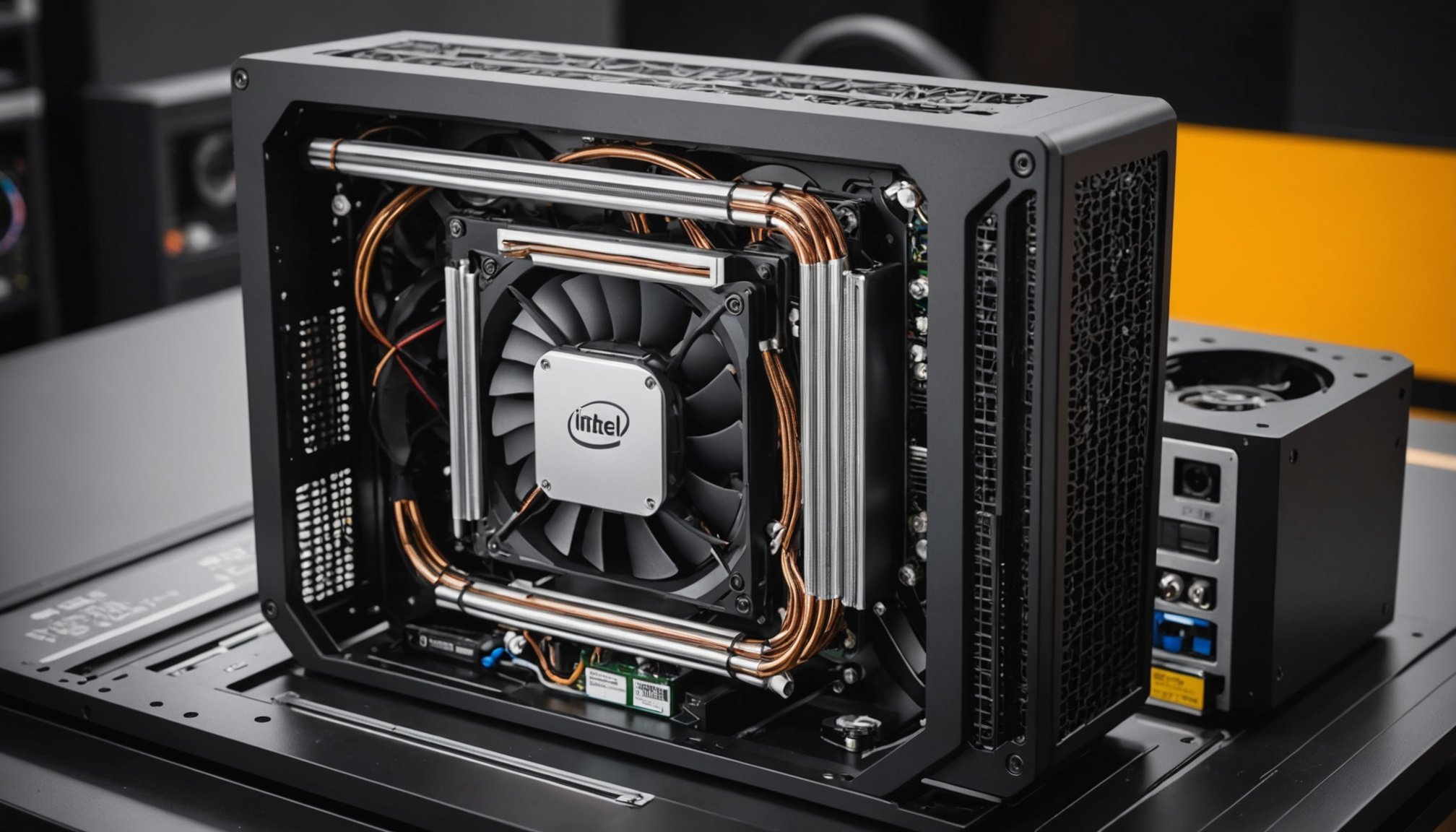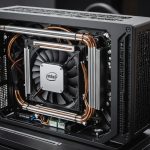Ultimate Guide to Enhancing Airflow and Cooling in Compact SFF Cases for Intel Core i7-10700K
Understanding the Challenges of SFF Cases
When it comes to building a powerful PC in a compact Small Form Factor (SFF) case, one of the most significant challenges is ensuring adequate airflow and cooling. The Intel Core i7-10700K, with its high performance capabilities, demands a well-designed cooling system to maintain optimal temperatures. Here, we’ll delve into the strategies and components that can help you achieve superior airflow and cooling in these tight spaces.
Choosing the Right Case
The foundation of any successful SFF build is the case itself. Here are some key features to look for in a case designed to handle high-performance components like the Intel Core i7-10700K:
Also to discover : Unlocking Top Performance in 3D Rendering and CAD: Proven Techniques for Your Dell Precision 5750
Key Features for SFF Cases
- Compact yet Spacious: Look for cases that offer a compact footprint but still provide enough room for your components. For example, the Cooler Master Ncore 100 Air boasts a 14.7L size, comparable to a small booklet, yet supports triple-slot GPUs up to 336 mm and ITX motherboards[1].
- Superior Airflow: Cases with large mesh air vents and efficient thermal layouts are crucial. The Corsair 2000D Airflow, for instance, features multiple fan mounts and supports up to a 360mm AiO cooler, ensuring excellent airflow[3].
- Tool-less Design: An open, tool-less design can significantly simplify the building and upgrading process. The Ncore 100 Air and the Corsair 2000D Airflow both offer this convenience[1][3].
- Hardware Compatibility: Ensure the case supports your chosen hardware, including the CPU, GPU, and power supply. The Thermaltake Tower 200, for example, can accommodate high-performance components like large GPUs up to 380mm in length and CPU coolers up to 200mm in height[3].
Cooling Solutions for High-Performance CPUs
Cooling is paramount when dealing with powerful CPUs like the Intel Core i7-10700K. Here are some strategies and components to consider:
Air Cooling
- High-Performance Air Coolers: Air coolers like the Noctua NH-U14S TR4-SP3 can provide excellent cooling performance in compact cases. These coolers are designed to be tall but slim, fitting within the height constraints of most SFF cases[4].
- Fan Placement: Proper fan placement is critical. Cases like the SSUPD Meshlicious support multiple fan mounts, allowing you to configure your cooling setup for optimal airflow[3].
Liquid Cooling
- All-in-One (AiO) Liquid Coolers: AiO liquid coolers are highly effective in SFF cases due to their compact design and high cooling efficiency. The Cooler Master MasterLiquid 360L, for example, is a 360mm AiO cooler that can be mounted in cases like the Corsair 2000D Airflow[2][3].
- Custom Water Cooling: For those who want to push the limits, custom water cooling setups can be tailored to fit within SFF cases. However, this requires careful planning and precise component selection to ensure compatibility and performance.
Enhancing Airflow in SFF Cases
Airflow is crucial for maintaining cool temperatures in compact cases. Here are some tips to enhance airflow:
Also read : Upgrade your it game: quality refurbished servers await
Case Design and Ventilation
- Mesh Panels: Cases with full-mesh panels, such as the SSUPD Meshlicious, provide excellent airflow. These panels allow for unobstructed air intake and exhaust, which is vital in SFF builds[3].
- Ventilation Paths: Ensure the case has well-designed ventilation paths. The Thermaltake Tower 200, for instance, intakes cold air from the bottom and sides and expels hot air through the top and rear, effectively managing thermals[3].
Fan Configuration
- Multiple Fan Mounts: Cases with multiple fan mounts offer flexibility in configuring your cooling setup. The Corsair 2000D Airflow supports three 120mm fans on the front and additional fans on the side and rear[3].
- Fan Placement Strategies:
- Intake Fans: Place intake fans at the bottom or front of the case to draw in cool air.
- Exhaust Fans: Position exhaust fans at the top or rear to expel hot air.
- GPU Cooling: Use slim fans or dedicated GPU coolers to ensure your graphics card remains cool.
Power Supply and Cable Management
A well-chosen power supply and effective cable management are essential for maintaining airflow and reducing clutter in SFF cases.
Power Supply Considerations
- SFX and SFX-L Power Supplies: These compact power supplies are designed for SFF cases and offer high efficiency. The Ncore 100 Air supports SFX and SFX-L power supplies, ensuring compatibility with a wide range of high-performance builds[1].
- Fully Modular Power Supplies: Fully modular power supplies help in reducing cable clutter, which is crucial in tight spaces. Look for gold-certified power supplies for high efficiency and reliability.
Cable Management
- Cable Routing: Use cable ties and routing channels to keep cables organized and out of the way. Cases like the Lian Li Lancool III RGB offer excellent cable management options, including movable front IO and ample space behind the motherboard[5].
- Cable Length: Choose components with shorter cables to minimize clutter. For example, using a shorter power supply cable can help in keeping the case tidy.
Practical Examples and Case Studies
Let’s look at some practical examples of how these strategies can be implemented:
Cooler Master Ncore 100 Air
- This case is designed with modern users in mind, offering a compact 14.7L size, an open tool-less design, and superior airflow through large mesh air vents. It supports triple-slot GPUs up to 336 mm and ITX motherboards, making it an ideal choice for high-performance SFF builds[1].
Thermaltake Tower 200
- This case features a unique “fridge-like” vertical design with a tempered glass front panel and perforated sides, ensuring both aesthetic appeal and optimized airflow. It supports high-performance components, including large GPUs and CPU coolers, and includes a GPU stabilizer for added security[3].
Comparative Analysis of Top SFF Cases
Here’s a comparative table of some top SFF cases, highlighting their key features and suitability for high-performance builds:
| Case Model | Dimensions (LxWxH) | Power Supply Support | GPU Support | Max CPU Cooler Height | Fan Support | Front I/O |
|---|---|---|---|---|---|---|
| Cooler Master Ncore 100 Air | 155 mm x 212 mm x 449 mm | SFX, SFX-L | Up to 336 mm | – | Pre-installed low-profile fan | USB Type-A, Type-C, Audio combo plug |
| Corsair 2000D Airflow | 271 mm x 200 mm x 458 mm | SFX-L, SFX | Up to 365 mm | Up to 165 mm | 3x 120mm front, 3x 120mm/2x 140mm right panel | 1x USB 3.2 Gen 2 Type C, 2x USB 3.2 Gen 1 Type A, 1x Audio in/out |
| Thermaltake Tower 200 | – | ATX, SFX | Up to 380 mm | Up to 200 mm | 2x 140mm pre-installed | USB Type-A, Type-C, Audio in/out |
| SSUPD Meshlicious | – | SFX, ATX | Up to 280 mm | – | Multiple fan mounts | USB Type-A, Type-C |
| Corsair 2500D Airflow | – | SFX | Up to 335 mm | Up to 165 mm | 3x 120mm front, 2x 140mm right panel | USB Type-A, Type-C |
Quotes and Insights from Experts
- Jimmy Sha, Cooler Master CEO: “The Ncore 100 Air is more than just a PC case; it’s a statement for builders who value simplicity, performance, and style. We designed this product to meet the needs of gamers and creators who want powerful hardware in a compact, elegant form.”[1]
- Cooling Experts: “For high-performance components like the Intel Core i7-10700K, it’s crucial to have a well-designed cooling system. This includes choosing the right case, cooler, and fan configuration to ensure optimal airflow and thermal management.”[4] and Final Tips
Building a high-performance PC in a compact SFF case requires careful planning and the right components. Here are some final tips to keep in mind:
- Plan Ahead: Before starting your build, ensure you have a clear plan for your cooling setup, cable management, and component compatibility.
- Choose the Right Components: Select components that are designed for SFF builds, such as SFX power supplies and compact coolers.
- Optimize Airflow: Use mesh panels, multiple fan mounts, and strategic fan placement to optimize airflow within your case.
- Monitor Temperatures: Keep an eye on your system temperatures to ensure your cooling setup is performing as expected.
By following these guidelines and choosing the right components, you can create a powerful and efficient SFF PC that meets your gaming, content creation, or general computing needs, all while maintaining a sleek and compact form factor.










